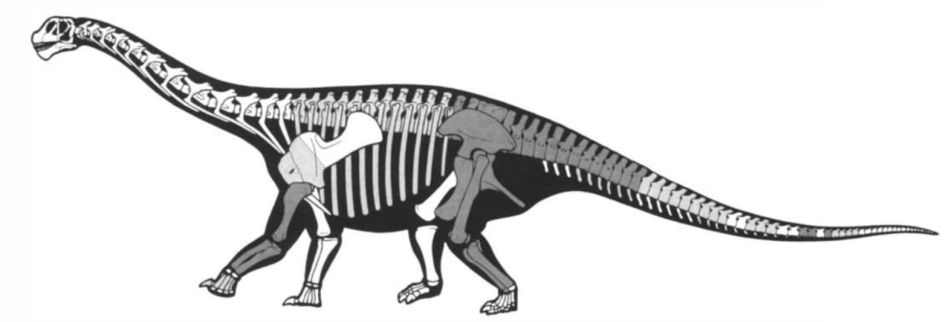Kyrgyzstan 2024 "Prehistoric animals of Kyrgyzstan"
| <prev | back to index | next> |
| Issue Date | 30.04.2024 |
| ID | Michel: 203-205; Scott: 184-186; Stanley Gibbons: Yvert: 178-180; Category: pR |
| Designer |
Artwork: Daria Maier, Kyrgyz Express Post, Moldova. Technical support: Michael Kogan, Germany - author of https://www.paleophilatelie.eu webiste; Aizek Asanbekovich Bakirov, the acting director of the M. M. Adyshev Institute of Geology of the National Academy of Sciences of the Kyrgyz Republic. |
| Stamps in set | 3 |
| Value |
KGS 50 - Sharovipteryx mirabilis KGS 150 - Stegosaur KGS 300 - Ferganasaurus verzilini |
| Emission/Type | commemorative |
| Issue place | Bishkek |
| Size (width x height) | stamps: 69.00 mm × 27.50 mm Mini-Sheet of 5: 159 mm x 108 mm Mini-Sheet of 3: 124 mm x 80 mm |
| Layout | 3 Mini-Sheets of 5 stamp + 1 tab 1 Mini-Sheet of all 3 stamps |
| Products | FDC x4, MC x3 |
| Paper | coated, gummed, 105 g/m2 |
| Perforation | 14 x 14.50 |
| Print Technique | full-colour offset lithography |
| Printed by | "Nova Imprim" (Chișinău, Moldova). |
| Quantity | stamps in Mini-Sheets of 5: 9.600 Mini-Sheet of 3: 3.600, Maxi-Cards: 400, FDC: 400. |
| Issuing Authority | Kyrgyz Express Post |
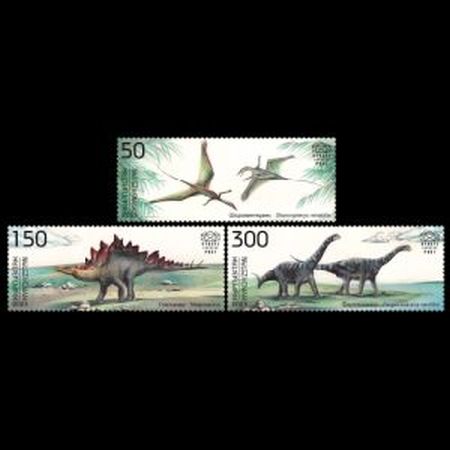
On April 30th, 2024, after a delay of two years, the Ministry of Digital Development of the Kyrgyz Republic placed into circulation a series of Kyrgyz Express Post (KEP) postage stamps: "Prehistoric Fauna of Kyrgyzstan".
These stamps were issued in Mini-Sheets of five stamps plus a label showing fossils of the animals discovered in Kyrgyzstan and a Mini-Sheet with all three stamps with Ferganocephale adenticulatum on the margin.
The set contains three stamps:
- KGS 50 - postcard rate - Sharovipteryx mirabilis
- KGS 150 - regular letter with weight up to 50g. - Stegosaur
- KGS 300 - regular letter with weight up to 100g. - Ferganasaurus verzilini
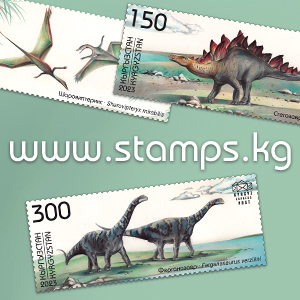 Dinosaurs and other prehistoric animals that dominated the Earth during the
Mesozoic Era became extinct approximately 66 million years ago.
As of today, over 700 species of dinosaurs are known.
Dinosaurs and other prehistoric animals that dominated the Earth during the
Mesozoic Era became extinct approximately 66 million years ago.
As of today, over 700 species of dinosaurs are known. Prehistoric fauna, particularly dinosaurs, is one of the most popular themes in philately. Special interest is garnered by stamps representing those species of prehistoric animals whose fossils have been discovered in the territory of stamp-issuing countries. These stamps of Kyrgyz Express Post are dedicated to such species of prehistoric fauna. Fossils of all four prehistoric animals were discovered in the Fergana Valley of Kyrgyzstan, as depicted on the cachet of the FDC.
The Fergana Valley in Central Asia lies mainly in eastern Uzbekistan, but also extends
into southern Kyrgyzstan and northern Tajikistan.
The Fergana Valley is an intermountain depression in Central Asia, between the
mountain systems of the Tien Shan in the north and the Alay in the south.
The valley is approximately 300 kilometres long and up to 70 kilometres wide,
forming an area covering 22,000 square kilometres.
Its position makes it a separate geographic zone.
The valley owes its fertility to two rivers, the Naryn and the Kara Darya, which
unite in the valley, near Namangan, to form the Syr Darya.
In the south of the valley, in the spurs of the Turkestan ridge, there is the
Madygen fossil locality, in which more than 15 thousand fossils of Triassic plants
(Ginkgoales, cycads, ferns, Neocalamitaceae) and animals
(insects, crustaceans, fishes, amphibians) were discovered.
The most numerous are insect fossils which include the large
Gigatitan from the extinct order Titanoptera with a wingspan
over 20 cm.
Unusual small reptiles, Longisquama with long scales, and
Sharovipteryx (shown on one of the stamps), which glided using a
membrane stretched between their paws, were also found here.
About the stamps design team:
Kyrgyz Express Post expresses its appreciation for valuable consultative
support in the preparation of this stamp issue to
Michael Kogan,
the author of the website www.paleophilatelie.eu, and
Aizek Asanbekovich Bakirov, the acting director of the M. M. Adyshev
Institute of Geology of the National Academy of Sciences of
the Kyrgyz Republic.
Daria Maier, the artist, explained about her work:
In December 2017, I met the head of the Kyrgyz Express Post (KEP) philatelic bureau, who offered me a collaboration. Although I had never created stamps before, I was interested in the idea because it was closely related to my area of expertise.I especially like that in this work I can combine artistic vision with historical accuracy, which makes every stamp unique in its own way.
Since 2018, stamps with my drawings and designs began to be issued. I'm interested in challenging myself in new directions, and there is no one topic that attracts me more than others.
This happened with the prehistoric fauna of Kyrgyzstan - the topic turned out to be very important and sometimes even frightening. Thanks to the presence of two incredibly knowledgeable consultants who accompanied me every step of the way, this challenge was successfully overcome.
I am sincerely grateful to Michael Kogan and Aizek Asanbekovich Bakirov for their valuable advice and corrections. I also express my gratitude to KEP for freedom of action, trust and the opportunity to directly communicate with the consultants.
In terms of execution, I preferred that the stamps not be too bright. I was leaning towards black and white, but in the end only the coupons, envelope and the postcards remained black and white. Color was added to the stamps, making the images more vibrant and expressive. The final drawings were done on paper using ballpoint pens and colored pencils to capture an antique feel with a bit of color. In this process, I strived for precision in detail so that each element reflected the true essence of the time and place depicted.
Often, when KEP participates in exhibitions, the head of the philatelic bureau takes the original drawings with him to show them to the public. I hope that someday the drawings for this issue will also be shown in exhibitions. This will be an opportunity to see the complexity of the process from the initial concept to the final execution and the importance of each stage of work on the brand. I hope to inspire new generations of collectors and artists through the theme and design, highlighting the cultural and historical significance of postage stamps.
Michael Kogan said:
In February 2021, I was contacted via Facebook by Daria Maier, stamp designer of Kyrgyz Express Post (KEP), who asked me for technical support for her work on prehistoric animal stamps, planned for 2022.Daria asked if I could help her select some dinosaurs to show on three stamps. I proposed to show prehistoric animals, not necessarily dinosaurs, that were discovered in Kyrgyzstan.

After we found information about more than a dozen interesting paleontological discoveries in the country, we started to think about the design concept. Should we show flying, terrestrial and marine animals, animals who lived in the same area, animals who lived during the same geological period, or the animals who belong to the same group?
I was impressed by Daria's dedication to paint as realistic images as possible, even though this was the first time she painted prehistoric animals.
At the end we decided on Geographic locations - fossils of all three prehistoric animals depicted on the stamps were discovered at the Fergana Valley of Kyrgyzstan. Ferganasaurus had never been shown on postage stamps before.
We also asked the Head of Philatelic Bureau if he would like to issue more sets of stamps depicting prehistoric animals of the country in the future. He liked the idea, therefore we hope this stamps set is just the first set and in the coming years we will have more stamps of KEP depicting prehistoric animals of the country.
The following prehistoric animals were depicted on the stamps
Sharovipteryx (Sharovipteryx mirabilis)
 |
| Sharovipteryx mirabilis on stamp of Kyrgyzstan 2024, MiNr.:, Scott: . |
Sharovipteryx ("Sharov's wonderful wing") is a genus of early gliding reptiles containing the single species Sharovipteryx mirabilis.
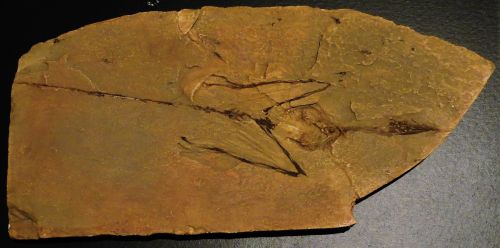 |
| The fossil of Sharovipteryx mirabilis. Image credit: Wikimedia |
Aleksandr Grigorevich Sharov (А.Г. Шаров, 1922–1973) was a Soviet paleontologist and expert on Pterosauria. Since 1951 he worked at the Paleontological Institute in Moscow. During 1960s and 1970s he worked in Central Asia's Republics of Soviet Union where he discovered many fossils, including Longisquama insignis (shown on First-Day-of-Issue Postmark) and Sordes pilosus (shown on stamp of USSR 1990 and Kazakhstan 1994).
Sharovipteryx is the only known flying vertebrate to have a flight system dominated by its hindlimbs. The specimen has a triangular (delta) wing membrane defined by the edges of its hindlimbs. With its unique hindlimb membrane, the forelimbs of this small reptile would have remained free during glides. Studies published in the journal Evolutionary Biology in 2006 by G.J. Dyke suggested, that a small forelimb membrane (about 10% area of the hindwing) would also have been favourable to balance this large rearward surface. This additional smaller moveable delta would have imparted improved stability for landing and gliding, allowing shallower glide angles. However, this additional, forelimb membrane, is not present in the fossil.According to recent research, it is unlikely that Sharovipteryx could flap its hindlimb wings however, its pelvis and hindlimb bones lacking suitable room and reinforcement for flapping muscle attachment. However, most paleontologists agree that these membranes could be deployed as a gliding apparatus simply by extending the legs sideways, a posture clearly attainable in life given the fossilised pose of our sole Sharovipteryx specimen.
The prehistoric animal lived during Triassic Period, 242-227 million years ago.
This lizard-like reptile was found in 1965 in the Madygen Formation, Dzailauchou, on the southwest edge of the Fergana Valley in Kyrgyzstan (former Soviet Union).
Sharov named the species Podopteryx mirabilis, "foot wing", for the wing membranes on the hind limbs. It became Sharov’s namesake in 1981 when it was realised that a damselfly already existed with the former name.
Although the relationships of Sharovipteryx to other reptiles remain somewhat ambiguous, most suggest they are part of Protorosauriaa, an early offshoot from the archosauromorphs which also includes weirdo taxa like Tanystropheus and the drepanosaurs. This relationship is suggested by the possession of membranous flight organs in both lineages and some similarity in hindlimb structure.
Sharovipteryx mirabilis was one of the smaller reptiles - about 20 cm in length, very thin and narrowly built with the weight estimation of 75 grams. Skin impressions adjacent to the skull, torso and feet show the body was covered with small scales, some of which overlapped. The head was small (19 mm long) and narrow with a short snout, large eyes, small nostril openings and at least 15 small, sharp and widely-spaced teeth in each jaw. The neck and trunk are long and narrow, and of approximately equal length. The narrow tail was at least as long as the body and neck combined.
It is assumed, that terrestrial locomotion and climbing was used when foraging, perhaps for insects, given the absence of adaptations for aerial prey capture. Likely, Sharovipteryx as spending much of its time in tree canopies.
The 225 million-year-old reptile Sharovipteryx mirabilis was the world’s first delta-winged glider; this remarkable animal had a flight surface composed entirely of a hind-limb membrane. Today's flying lizards, colugos, sugar gliders and flying snakes are nothing like it in terms of anatomy and gliding style.
Stegosaur (Stegosauria)
 |
| Stegosaur on stamp of Kyrgyzstan 2024, MiNr.:, Scott: |
The first partial skeleton of a stegosaurian dinosaur was discovered in a brick pit in Swindon, UK in 1874. It was described and named Omosaurus by Richard Owen in 1875. Later, this name was shown to be preoccupied by the phytosaur Omosaurus and the stegosaurian was renamed Dacentrurus. Since then, numerous stegosaurian remains have been discovered from Europe, North America, Africa and Asia, and continue to be discovered regularly. Asiatic stegosaurs are known predominantly from China. Stegosaurs are known from the Middle Jurassic to the Early Cretaceous; no definitive evidence of the clade is known from younger deposits.
The earliest skeletal records for Stegosauria are from the Bajocian – Bathonian of Sichuan Province, People’s Republic of China. The abundance and diversity of stegosaurs in the Middle Jurassic of Asia may suggest an Asiatic origin for the group. Currently, the Balabansai stegosaur is the most western record for the Stegosauria in Asia. The first nearly complete skeleton was discovered in the United States, in 1877. Professor Othniel Charles Marsh that year classified such specimens in the new genus Stegosaurus, from which the group acquired its name, and which is still by far the most famous stegosaurian. During the latter half of the twentieth century, many important Chinese finds were made, representing about half of the presently known diversity of stegosaurians.
Four articulated posterior dorsal vertebrae from the Middle Jurassic (Callovian) Balabansai Svita at Sarykamyshsai locality in the northern Fergana Valley represent the first record of Stegosauria in Kyrgyzstan.
These fossils were discovered by Kyrgyz-Russian paleontological expeditions in 2005 and 2006.
The vertebrae (shown on the top-left corner of the Mini-Sheet with Stegosauria stamps) cannot be attributed to any known stegosaurian genus and are classified as Stegosauria indet. (indeterminate).
Ferganasaurus (Ferganasaurus verzilini)
 |
| Ferganasaurus verzilini on stamp of Kyrgyzstan 2024, MiNr.:, Scott: |
In July 1966 the geological team of the Leningrad State University, led by Professor Nikita N. Verzilin, discovered a partial sauropod skeleton in the Middle Jurassic rocks of the upper part of the Balabansai Formation at Balabansai in the southern foothills of Chatkal Range, 5 km west of Tash-Kumyr, northern Fergana Valley, Kyrgyzstan, in that time Kyrgyz Republic of the Soviet Union. This was the first sauropod skeleton found in the USSR.
The excavation Ferganasaurus verzilini in the following year, by a team from the Moscow Paleontological Institute led by A. K. Rozhdestvensky, which recovered an essentially complete skeleton, lacking a skull, cervical and posterior caudal vertebrae, both hind feet and the right manus. Paleontologists suggest all the bones belong to a single individual. Some more fossils of the dinosaur were discovered by Russian-Kyrgyz paleontological expedition in 2000. These bones are reposited in the collections of the Paleontological Museum in Moscow.
In his book, "In Search for Dinosaurs to the Gobi", published in Moscow in 1969, Rozhdestvensky informally called this dinosaur "Ferganasaurus". For some reason, Rozhdestvesnky did not publish any studies of this dinosaur. Ferganasaurus was first formally described in 2003 by the Russian paleontologist Vladimir Alifanov and Alexander Averianov.
The only known species of the dinosaur is Ferganasaurus verzilini. The specific name was given in honour of Professor Nikita N. Verzilin, who discovered the first fossils of Ferganasaurus on one of the cliff slopes.
Ferganasaurus verzilini was a mid-sized sauropod, with relative short neck and tail, who lived between 166-163 million years ago, with estimated length of 18 meters and 5 meters in height. Its weight is estimated to have been 18 tons.
Ferganocephale (Ferganocephale adenticulatum)
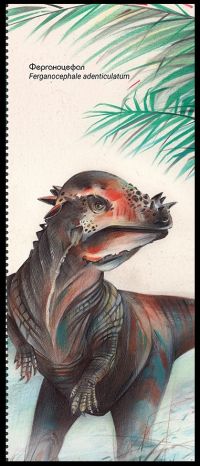 |
| Ferganocephale on margin of Mini-Sheet Kyrgyzstan 2024, MiNr.:, Scott: |
The species was described by an international team of paleontologists: Aleksandr Averianov (Russia), Aizek Bakirov (Kyrgyzstan) and Thomas Martin (Germany) in 2005. The description was based on teeth discovered in the Balabansai Svita in Fergana Valley, Kyrgyzstan.
The genus name combines the name of location it was found with the Greek kephale, "head", a reference to the presumed pachycephalosaurian affinities. The specific name means "without tooth serrations".
The age of the teeth was estimated between 165 and 161 million-year-old. Based on the teeth sizes, the size of the dinosaur was estimated to be 2 meters long and 60 centimeters high with weight of 20kg about.
The team assigned the dinosaur to pachycephalosaurian genus. Other paleontologists who have studied the teeth doubt that they belong to a pachycephalosaurian. Hopefully some more fossils of Ferganocephale will be discovered to allow more detailed and precise study of the prehistoric animal.
The First-Day-of-Issue Postmark shows another unique animal, which was also depicted on postage stamp of "Kyrgyz Pochtasy" in 2012, discovered in Fergana Valley.
 |
This is undoubtedly one of the most amazing animals. This lizard-like reptile was small in size up to about 15 cm long. Along the back of the animal protruded two rows of long feather-like scales. The length of these scales is longer than the length of the animal. Longisquama used them instead of a parachute. Jumping down from the tree, she unfolded a fan of scales and slowly lowered to the ground similar to a shuttlecock from badminton. It was one of the first attempts of a vertebrate to try flying as at the time only insects could fly. Perhaps insects were the diet of Longisquama, who preyed upon them by jumping down from the trees.
The following video "Dinosaurs time in UZBEKISTAN" shows some prehistoric animals of Uzbekistan but also includes prehistoric animals of neighboring Kyrgyzstan, including some prehistoric animals depicted on the stamps and the First-Day-of-Issue postmark.
Products and associated philatelic items
| Official FDC | Additional FDC offered by Kyrgyz Express Post | |
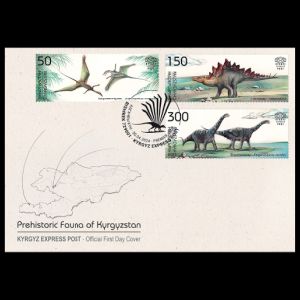 |
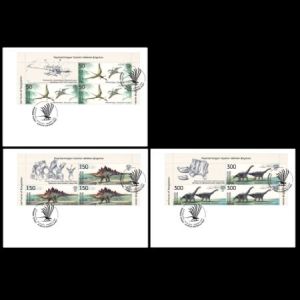 |
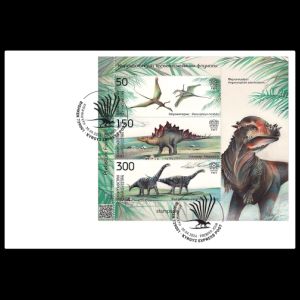 |
|
The reverse side of the FDC
contain a short descriptive text. The first day cover features a map of Kyrgyzstan with arrows indicating the locations where fossils of the respective prehistoric animals depicted on the stamps were discovered. |
||
| First-Day-of-Issue Postmark | Maxi Cards | Mini Sheet of 3 |
 |
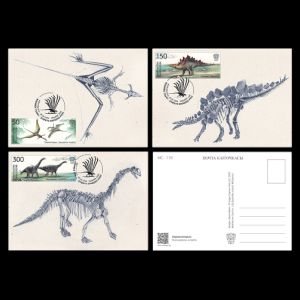 |
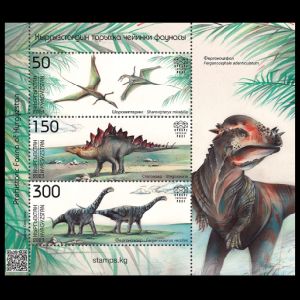 |
| Longisquama is shown on the postmark | ||
| Mini Sheets of 5+1 | ||
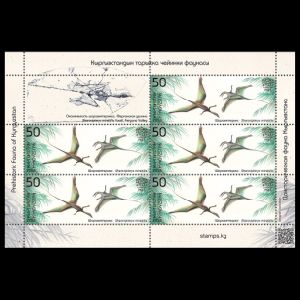 |
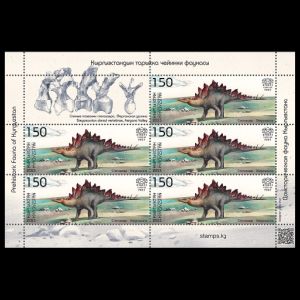 |
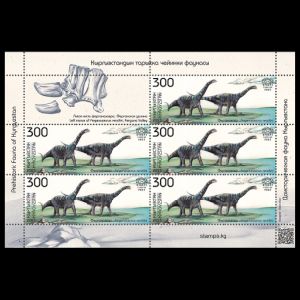 |
| Examples of Circulated Covers | ||
 |
 |
 |
| These two covers were inspected by customs to clarify whether there were goods inside or not. Likely, Customs examined the covers because the place-holder cartoon was too thick. Customs added the customs markings which I luckily was able to remove: [1], [2]. | ||
 |
|
 |
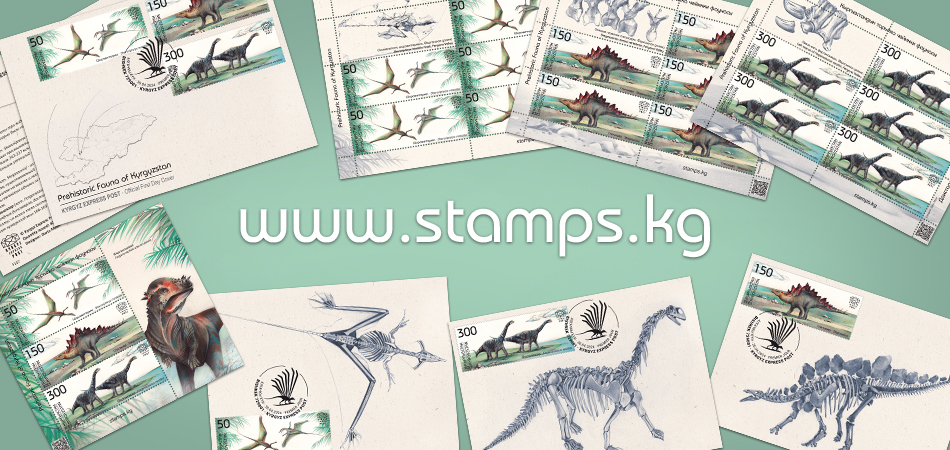
To order the "Prehistoric animals of Kyrgyzstan" stamps, in the on-line store of Kyrgyz Express Post, please click here.
References

|
- Technical details and official press release:
Newsletter no. 92 of Kyrgyz Express Post from 20 March 2024. - Fergana Valley: Wikipedia,
- Sharovipteryx:
Wikipedia,
Mark P. Witton blog,
Earth Archives,
Dyke, G. J., Nudds, R. L., & Rayner, J. M. V. (2006). "Flight of Sharovipteryx mirabilis: the world's first delta‐winged glider". Journal of Evolutionary Biology, 19(4), 1040-1043.- Aleksandr Grigorevich Sharov: Wikipedia,
- Stegosauria:
Wikipedia,
"First definitive stegosaur from the Middle Jurassic of Kyrgyzstan", Averianov, A. O., Bakirov, A. A., & Martin, T. (2007). - Ferganasaurus: Wikipedia, geoexplorersclub, lithology.
- Longisquama: Wikipedia,
Acknowledgements
Many thanks to Dr. Peter Voice, PhD Department of Geological and Environmental Sciences, Western Michigan University, USA, for his help in finding information and for review of a draft of this article.| <prev | back to index | next> |

